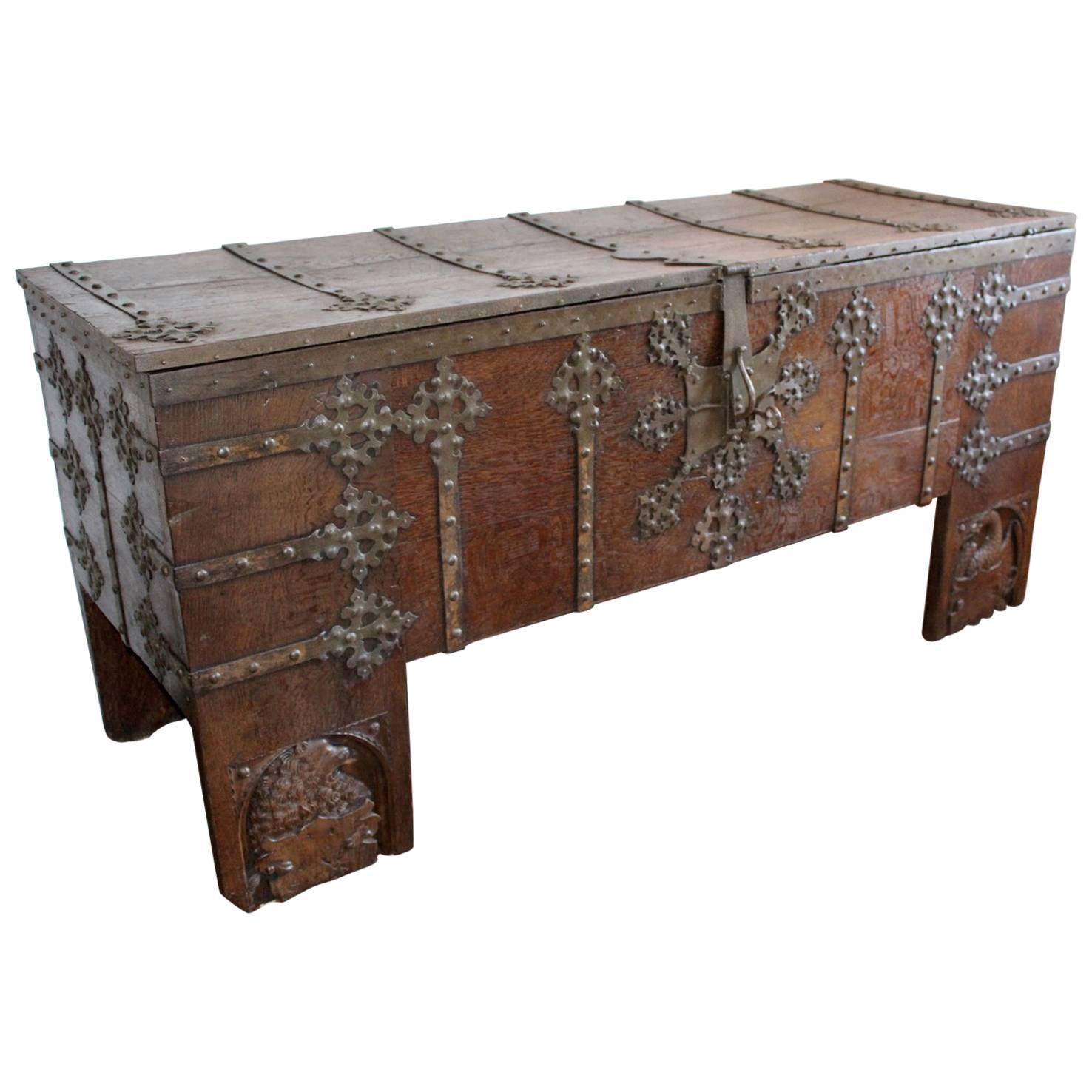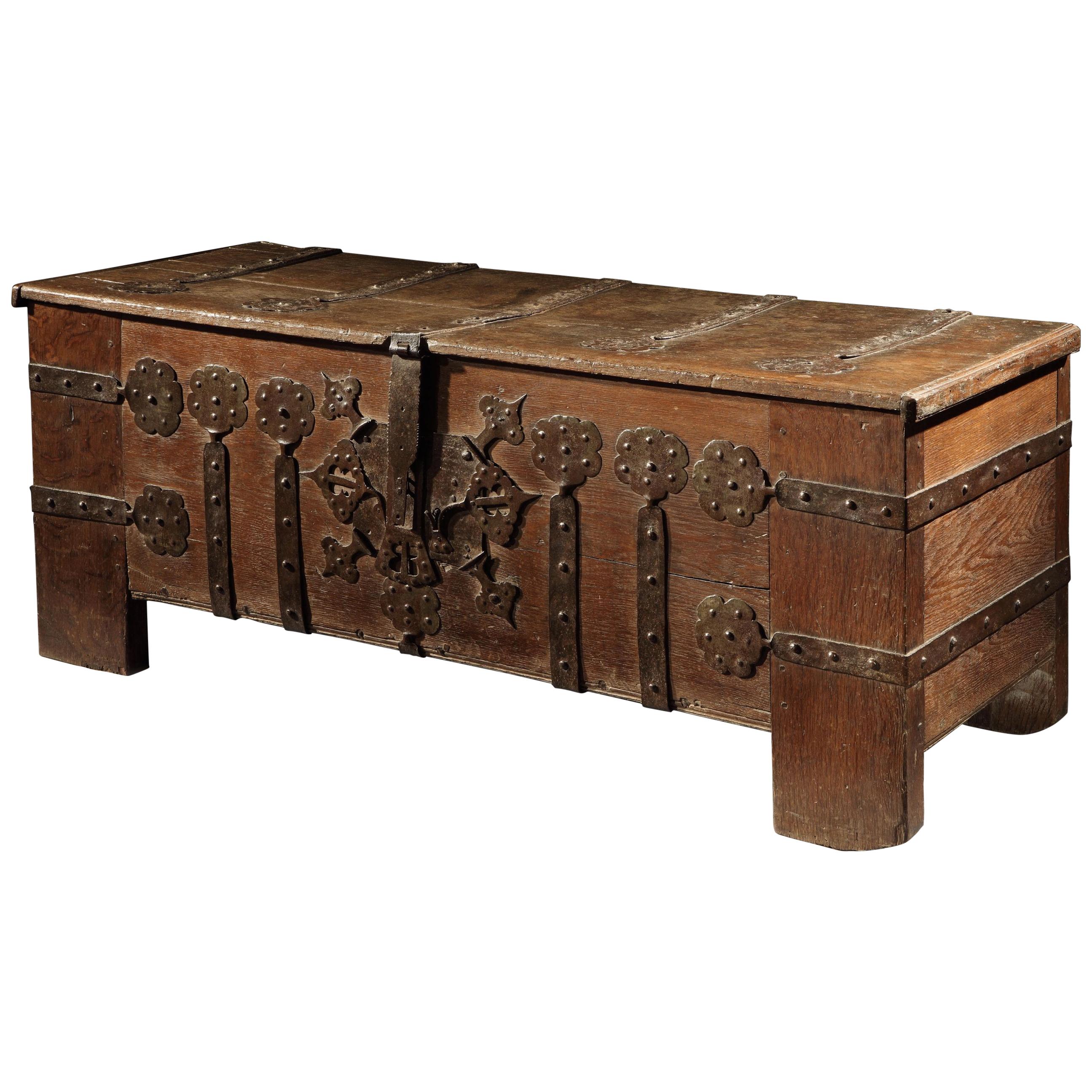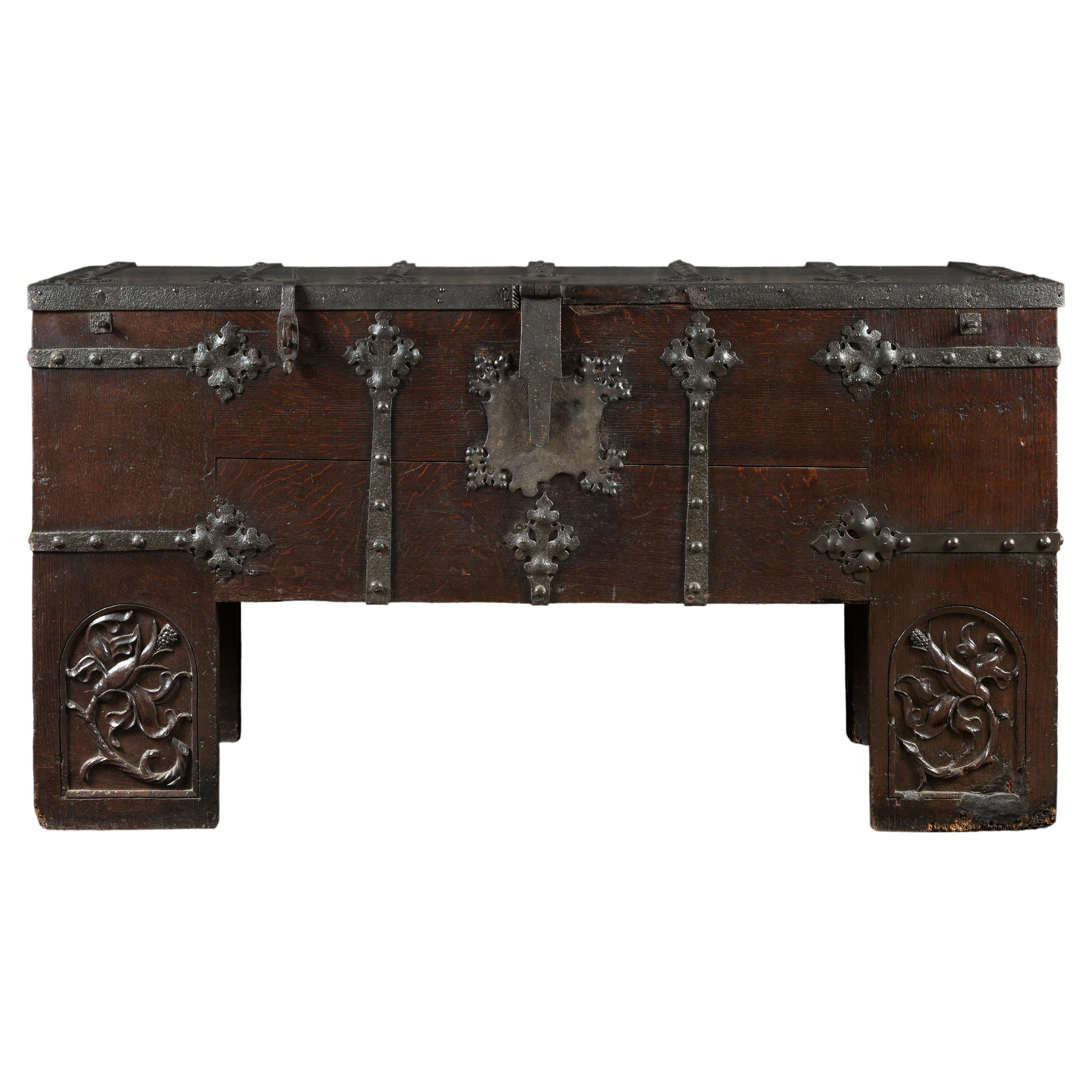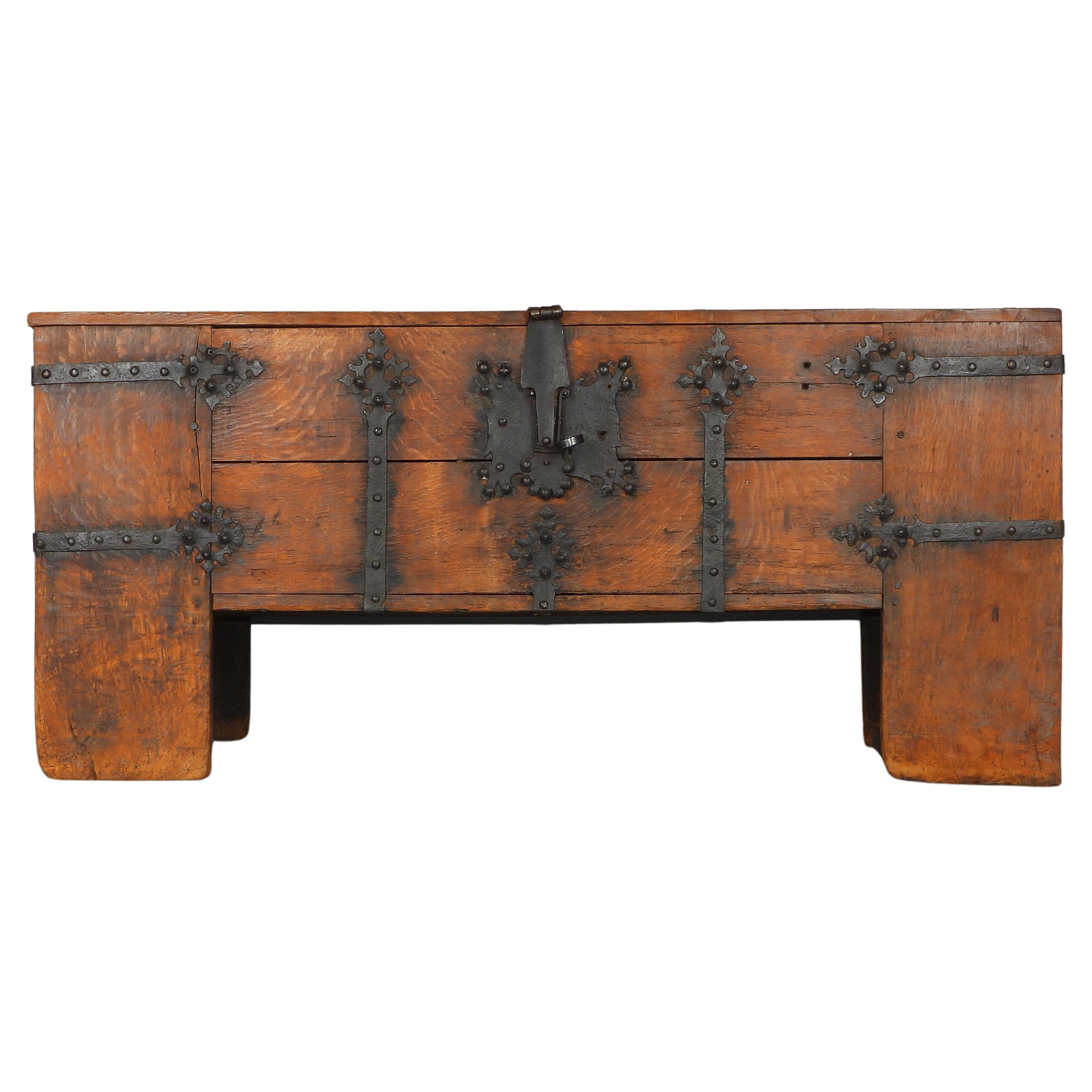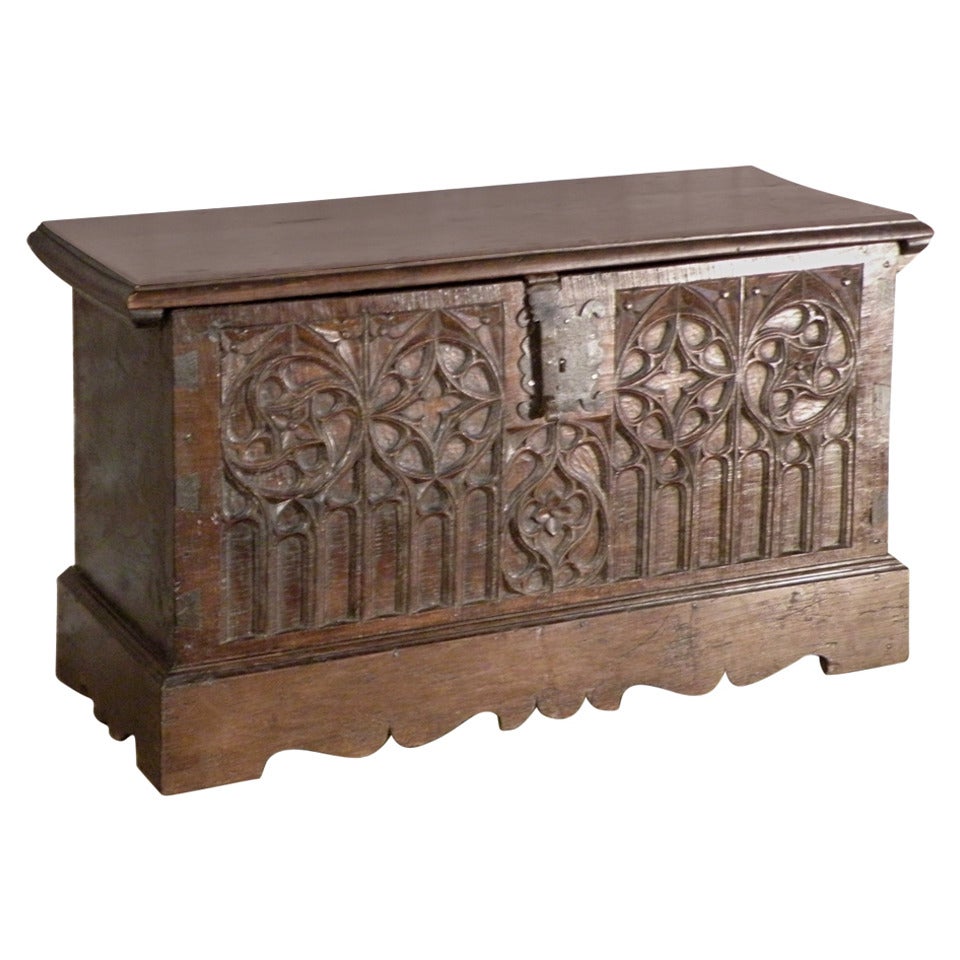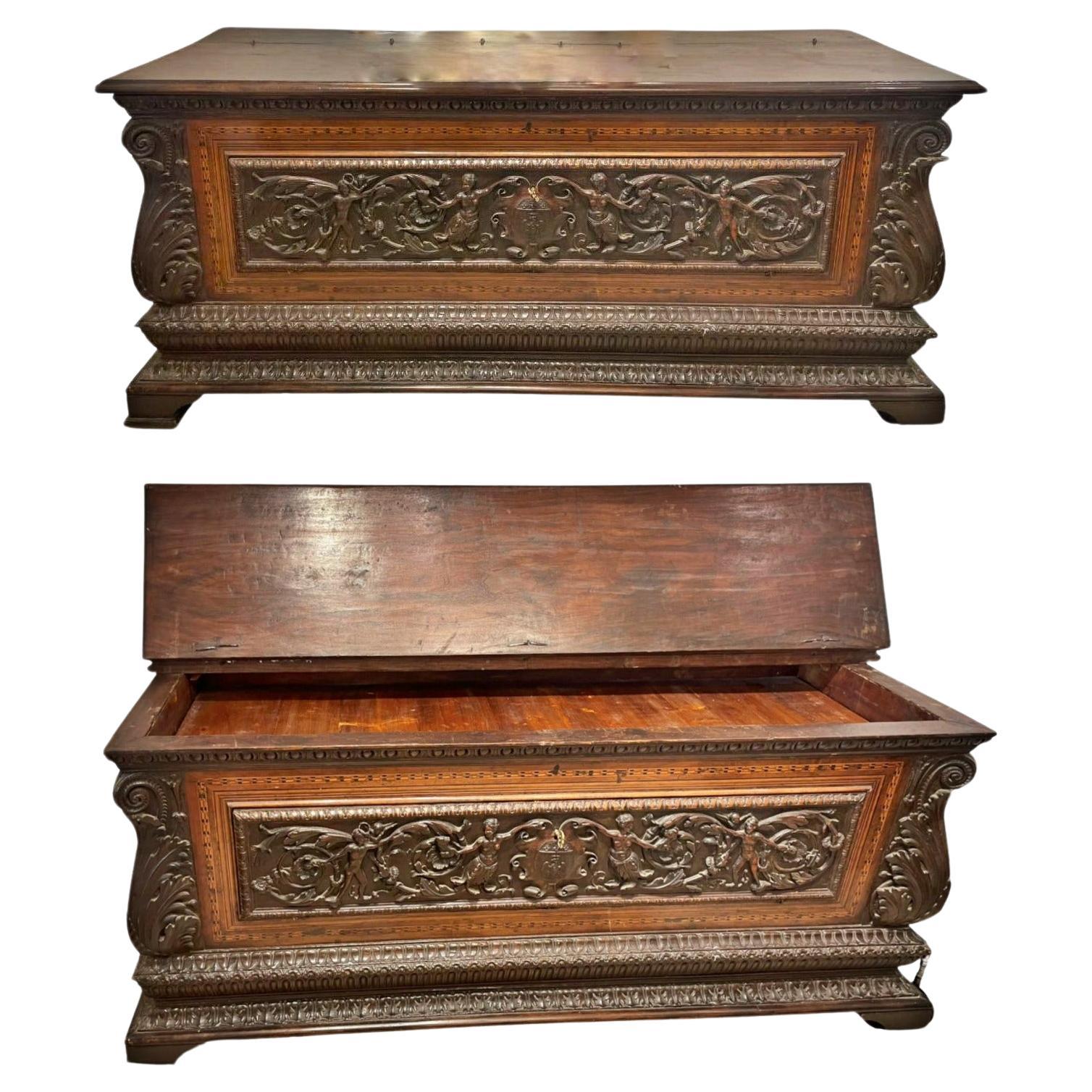Items Similar to Rare Late Medieval 16th Century German Wrought Iron Oak Chest or Stollentruhe
Want more images or videos?
Request additional images or videos from the seller
1 of 21
Rare Late Medieval 16th Century German Wrought Iron Oak Chest or Stollentruhe
About the Item
We have the pleasure to present a rare late medieval 16th century German wrought iron oak chest or Stollentruhe.
This is an early 16th century, circa 1500-1550, Stollentruhe or German Gothic chest from most likely Westphalia.
It is made of oak and tiger oak with exceptional wrought iron bands and adornments with a stunning central lock section and the original key and working lock.
Once opened it reveals a lidded and hinged candle box.
What adds to the exceptionality of this piece is it’s originality.
It only has one place where there is evidence of an historic repair, namely, the top/lid’s hinges. This is not surprising in the least, as with most chests from the 18th or 19th centuries will have replacement hinges due to the weight of the top when opened and breakages from being let fall backwards over time. When one considers that this chest is 500 years old it is hardly surprising that the hinges required some work, at some time, probably in the 19th century. In this case, one can see where a new wrought iron bracket has been placed on the back of the chest and attached to the original top bracket and hinge, thereby keeping it as original and true to its original construction as possible. One age crack to the lid/top but does not adversely affect the piece.
Apart from that repair this chest is simply stunning in its originality and construction. Everything else is original, right down to the handmade iron nails.
What elevates this piece in its desirability and collectability is the fact that it’s raised legs have never been cut down. These chests were always constructed on raised platform feet or legs as they would have stood on stone floors and raising the chest meant that the contents were protected from damp and wet. With most of these very early chests (both British and otherwise) the very bottom of the feet or platforms would rot over time due to coming into contact with wet, damp floors (think of mopping) this would result in the owners cutting the four legs to the same length to remove the rotted areas. It is very rare indeed, to find one of these chests that has not had its legs cut down over time.
Whilst, some of the other have more ornate decoration, this one is exceptional because of it’s originality.
This chest was in existence when Martin Luther was founding the reformation!
Most people refer to these as blanket chests, but on this I am going to slightly disagree, Whilst the candle box is often replicated in subsequent variations on the model of a blanket chest, I simply cannot reconcile the elaborate locking mechanism as being something that would be necessary to protect simple linens. Also, the height of the piece is not conducive to it being used at the base of a bed for bed linens. Also, the elaborate banding and craftsmanship of the wrought iron is something that was intended for display and not to be hidden away in a bedroom.
In my opinion, therefore, this is a silver or treasure chest for keeping valuables securely under lock and key, like for example, silver candelabras etc. …. hence the candle box.
Construction The chest is of joined, ‘clamp-front’ construction, reinforced by the nailed, iron mounts. In total it uses ten, oak boards which were riven and planed. The back and front are each formed from a large single plank held to the full height stiles by long, pegged tenons. The sides are also single boards joined into the stiles using long tenons held by dowels, and extend down below the chest bottom, concealing the ends of the bottom boards. The bottom consists of a single board cut into the sides and shallow rebates in the stiles. The front and back boards are dowelled into the bottom boards. The lid which overhangs the sides has a narrow cleat at each end, and consists of one wide plank which has bowed a little as a result of shrinkage.
Ironwork: The wrought ironwork straps, lock plate, hasp and lock all appear all appear to be early, and of the same original manufacture and are fixed with convex headed nails. There is mild dark staining of the oak around the iron mounts, possibly because of low tannin content in the oak.
Related to: No 900:2-1904 V&A Museum, London. Stadtmuseum Dusseldorf. Decorative Arts Museum Berlin. Museen Schleswig-Holstein & Hamburg. A related example featuring elaborately-carved feet and formerly in the Horsham Museum, West Sussex, sold at Christie’s in 2010 for £97,250 and another example, again with carved feet sold at Sothebys in 2006 for £48,000.
Literature: A similar example is illustrated in H. Lüttgens, Alt- Aachener Wohnkultur; Ein Rundgang durch ein altes Aachener Haus im Wohnstil des 18. Jahrhunderts, Aachen, n.d., ill. 12, and another comparable iron-bound chests illustrated in H. Kreisel, Die Kunst des Deutschen Möbels, Munich, 1974, pls. 45-46.
This type of large oak standing chest is known as a ‘stollentruhe’ (studded chest) and is thought to have been made from at least the early-16th century, based on the style of ironwork and form of the front legs which tend to be carved on earlier models. The German Renaissance was established and Albrecht Dürer and Lucas Cranach the elder were famous throughout Europe. The type has become closely associated with the Westphalia region in central, western Germany (between the Rhine and Weser rivers, located north and south of the Ruhr River).
Comparative literature • Baumeier, Stefan, Beschlagene Kisten; Die ältesten Truhen Westfalens, Essen, 2012.
• Falke, Otto von, Deutsche Möbel des Mittelalters und der Renaissance, Stuttgart, 1924.
• Kreisel, Heinrich, Die Kunst des deutschen Möbels, Von den Anfängen bis zum Hochbarock, München, 1968, Band I.
• Stülpnagel, Karl Heinrich von, Die gotischen Truhen der Lüneburger Heideklöster, Cloppenburg, 2000.
• Windisch-Graetz, Franz, Möbel Europas, Band I, Von der Romanik zur Spätgotik, München, 1982.
- Dimensions:Height: 35.5 in (90.17 cm)Width: 69.5 in (176.53 cm)Depth: 24.5 in (62.23 cm)
- Style:Gothic (Of the Period)
- Materials and Techniques:
- Place of Origin:
- Period:
- Date of Manufacture:1500-1550
- Condition:Repaired: Hinges only. Wear consistent with age and use. Minor losses. Very good original condition. See full posting for details.
- Seller Location:Dallas, TX
- Reference Number:1stDibs: LU3978122120762
About the Seller
4.9
Gold Seller
These expertly vetted sellers are highly rated and consistently exceed customer expectations.
Established in 2015
1stDibs seller since 2018
349 sales on 1stDibs
Typical response time: <1 hour
- ShippingRetrieving quote...Ships From: Dallas, TX
- Return PolicyA return for this item may be initiated within 7 days of delivery.
More From This SellerView All
- 17th Century English Carved Oak Dowry ChestLocated in Dallas, TXPresenting an absolutely gorgeous and historic 17th century English carved oak dowry chest. Made of solid oak in England,...Category
Antique Early 17th Century English Jacobean Blanket Chests
MaterialsOak
- 19C English Naval Captain's Sea ChestLocated in Dallas, TXPRESENTING a GORGEOUS 19C English Naval Captain’s Sea Chest. Made in Britain, probably England, circa 1851-55. Early Victorian Era. Made of...Category
Antique Mid-19th Century English Early Victorian Blanket Chests
MaterialsOak
- 18C Irish George II Mahogany Silver Chest on Exceptional Carved StandLocated in Dallas, TXPRESENTING AN ‘ABOLUTELY STUNNING’ PIECE OF IRISH FURNITURE HISTORY, namely, an 18C Irish George II Mahogany Silver Chest on the most amazing and EXCEPTIONAL Carved Stand. Made circa 1745, by an obviously ‘top quality’ Irish Georgian furniture...Category
Antique Mid-18th Century Irish George II Blanket Chests
MaterialsMahogany
- 18th Century George II Miniature Campaign Bureau Chest on Later Chest StandLocated in Dallas, TXPRESENTING A GORGEOUS and beautifully proportioned Mid-18th Century George II Miniature Campaign Bureau Chest on later Chest/Stand. Mid-18th century, made in Britain, circa 1760-1770. The bureau chest sits on a later stand/chest, that we estimate is late 19th century, circa 1860-1880. It is also British. We believe that the primary wood in this piece is either Elm or Sycamore with mahogany elements. Classic Campaign style miniature Bureau Chest, with its ORIGINAL George II brass hardware, including handles on the sides for easy carriage, which is what proves to us, that this chest was made for campaign purposes. The brasses are GORGEOUS and are classically George II in style, design and construction. The quality, thickness and patina to the brasses, is what ‘initially’ tells us, that this is a ‘period’ piece and not a reproduction. Likewise, the dovetailing detail to the drawers, tells us that this was a hand crafted piece and certainly NOT machine made. The secondary woods appear to be a combination of oak and pine, exactly as one would expect. The central keyhole escutcheons are FANTASTIC and are in the form of a pair of opposing ‘lyres’. We have never seen anything like them! Beautiful natural patina! The ‘brasses’ look like they have been polished a ‘little too often and vigorously’, over the piece’s 250+ years history … BUT … the bonus of this cleaning is the creation of a rather appealing, '2 Tone effect’, on the patina of the wood around the brasses. The Bureau has a flat gallery...Category
Antique 18th Century English George II Secretaires
MaterialsBrass
- Rare 19th Century English Tunbridgeware Hair Pin or SlideLocated in Dallas, TXPresenting an absolutely gorgeous and extremely unique and rare 19th century British Tunbridgeware hair pin/bobbin or slide. This slide is unlike any of it’s kind we have seen before…. it is a very rare survivor ! From circa 1860–1880. Made of walnut with gorgeous marquetry inlay on the entirety of the front with classic Tunbridgeware micro-mosaic all over the front. The rear is walnut. The marquetry inlay appears to be various different woods, namely, maple, walnut and satinwood. Would have been worn in a Lady’s hair bun with the micro-mosaic facing forward. This would have belonged to a very elegant lady in the mid to late 19th century. Tunbridge ware is a form of decoratively inlaid woodwork, typically in the form of boxes, that is characteristic of Tonbridge and the spa town of Royal Tunbridge Wells in Kent in the 18th and 19th centuries. The decoration typically consists of a mosaic of many very small pieces of different coloured woods that form a pictorial vignette. Shaped rods and slivers of wood were first carefully glued together, then cut into many thin slices of identical pictorial veneer with a fine saw. Elaborately striped and feathered bandings for framing were pre-formed in a similar fashion. There is a collection of Tunbridge ware in the Tunbridge Wells Museum and Art Gallery in Tunbridge Wells. The famous makers of Tunbridge ware were in the Tunbridge Wells area of Kent; their most notable work was from circa 1830-1900. Early makers of Tunbridge ware, in Tunbridge Wells in the mid-18th century, were the Burrows family, and Fenner and Co. In the 19th century, around 1830, James Burrows invented a technique of creating mosaics from wooden tesserae. Henry Hollamby, apprenticed to the Burrows family, set up on his own in 1842 and became an important manufacturer of Tunbridge ware, employing about 40 people. Edmund Nye (1797–1863) and his father took over the Fenner company when William Fenner retired in 1840, after 30 years in partnership with him. Thomas Barton (1819–1903), previously apprenticed at the Wise factory, joined the Nyes in 1836, and worked as Nye’s designer; he took over the business in 1863 and continued there until his death. In Tonbridge (near to Tunbridge Wells), George Wise (1703–1779) is known to have had a business in 1746. It continued with his son Thomas, and Thomas’s nephew George (1779–1869), who took over in 1806. In its early years the company made articles such as workboxes and tea caddies with prints of popular views; later items had pictures created from mosaics. Their workshop in Tonbridge, Wise’s Tunbridge Ware Manufactory, was next to the Big Bridge over the Medway; the building was demolished in 1886 to widen the approach to the bridge. Tunbridge ware became popular with visitors to the spa town of Tunbridge Wells, who bought them as souvenirs and gifts. Articles included cribbage boards, paperweights, writing slopes, snuffboxes and glove boxes. At the Great Exhibition of 1851, Tunbridge ware by Edmund Nye, Robert Russell and Henry Hollamby was shown; Edmund Nye received a commendation from the judges for his work. He exhibited a table depicting a mosaic of a ship at sea; 110,800 tesserae were used in making the picture. The manufacturers of Tunbridge ware were cottage industries, and they were no more than nine in Tunbridge Wells and one in Tonbridge. The number declined in the 1880s; competent craftsmen were hard to find, and public tastes changed. After the death of Thomas Barton in 1903 the only surviving firm was Boyce, Brown and Kemp, which closed in 1927. Marquetry was an old technique which was continued by Nye and Barton to create images such as birds or butterflies. ‘Green Oak’ as caused by the fungus Chlorociboria aeruginascens. Stickware and half-square mosaic was invented by James Burrows in about 1830: a bunch of wooden sticks of different colours, each having triangular or diamond-shaped cross section, were tightly glued together; in the case of stickware, the resulting block was dried, then turned to form an article such as the base of a pincushion. For half-square mosaic, thin slices were taken from the composite block, and applied to a surface.[1][2][4] Tesselated mosaic, was a development by James Burrows of half-square mosaic; it was adopted by George Wise and Edmund Nye. Minute tesserae were used to form a wide variety of geometric and pictorial designs. Many sorts of wood were used for the various colours; about 40 were in regular use. Only natural colors were used; green was provided by “green oak”, produced by the action of fungus on fallen oak. Designs for articles were often taken from designs of Berlin wool work.Category
Antique Late 19th Century English High Victorian Collectible Jewelry
MaterialsSatinwood, Walnut
- 19th Century Pair of Polish/German Stoneware FiguresLocated in Dallas, TXPresenting a lovely 19th century pair of Polish/German stoneware figures. Quite rare! Not a matching pair but similarly themed, with the little girl holding a basket of kittens with one kitten climbing up her front and the other of a little boy climbing a tree stump with a snail at the base. The ‘Little Girl’ is painted stoneware or earthenware and we are of the opinion is Polish in origin (or possibly Russian). It does not have any identifiable markings but it was originally with another similar style figurine (not included in this sale) which had markings that we were of the opinion were Polish markings. The ‘Little Boy’ is painted pottery and we are of the opinion that it is either Polish or German in origin. It is slightly different in style an texture to the girl and has a more ‘bisque’ finish. The facial features are more defined and remind me of German bisque dolls...Category
Antique Late 19th Century Polish High Victorian Figurative Sculptures
MaterialsPottery
You May Also Like
- Rare Late Medieval 16th Century German Wrought Iron Oak Chest or StollentruheLocated in Worpswede / Bremen, DEA very impressive Westphalian Gothic chest or ‚Stollentruhe’, Westphalia, Germany, circa 1500-1550. Wrought iron mounted oak, partially carved. The monumental rectangular standing chest with full-height stiles, extensively mounted with wrought ironwork straps terminating in quatrefoil finials which ’wrap’ around the chest edges. These are fixed with convex head nails. The ironwork with some remains of an originally red painted surface. In addition, running along the edges of the lid at the front and sides is a plain iron band, close-nailed. The feet of the two front legs are finely carved on the front face, in low relief with a rectangular arched ’panel’ depicting on the left a lion, on the right a dragon holding each a coat of arms. Regarding the age of circa 500 years, this coffer is in exceptionally good condition, with only smaller restorations. Comparative literature • Baumeier, Stefan, Beschlagene Kisten; Die ältesten Truhen Westfalens, Essen, 2012. • Falke, Otto von, Deutsche Möbel...Category
Antique 16th Century German Medieval Blanket Chests
MaterialsIron
- Chest or Stollentruhe, Early 16th Century, German Gothic, Oak Chest, OriginalLocated in BUNGAY, SUFFOLKThis standing chest is of clamp-front construction, extensively decorated with long, ironwork straps with quatrefoil finials which ‘wrap’ around it, and has an ornate, central lockplate, and front legs with full, height stiles. The ironwork straps and finials are fixed with convex, headed nails: running along the front, five long straps; the two side straps; and the five straps on the top. On the chest front, centrally placed, is a large, iron lockplate with four outer, radiating spade finals in each corner and three, superimposed spade finials (a symbol of nobility) which are pierced with the initials ‘BB’. The lockplate receives a corresponding, external hasp fitted to the lid. Below the floor of the chest, the two front stile legs retain most of their original height. The lid is supported by substantial iron strap hinges that extend right down the back of the chest. Inside the chest at the left end is a shallow, oak till. Construction The chest is of joined, 'clamp-front' construction, reinforced by the nailed, iron mounts. In total it uses ten, oak boards which were riven and planed. The back and front are each formed from a large single plank held to the full height stiles by long, pegged tenons. The sides are also single boards joined into the stiles using long tenons held by dowels, and extend down below the chest bottom, concealing the ends of the bottom boards. The bottom consists of a single board cut into the sides and shallow rebates in the stiles. The front and back boards are dowelled into the bottom boards. The lid which overhangs the sides has a narrow cleat at each end, and consists of one wide plank which has bowed a little as a result of shrinkage. Ironwork : The wrought ironwork straps, lockplate, hasp and lock all appear all appear to be early, and of the same original manufacture and are fixed with convex headed nails. There is mild dark staining of the oak around the iron mounts, possibly because of low tannin content in the oak. Length 172 cm., 67 ¾ in., Height 71.5 cm., 28 ¼ in., Depth 63 cm., 24 ¾ in., Related to: No 900:2-1904 V&A Museum, London. Stadtmuseum Dusseldorf. Decorative Arts Museum Berlin. Museen Schleswig-Holstein & Hamburg. A related example featuring elaborately-carved feet and formerly in the Horsham Museum, West Sussex, sold at Christie's in 2010 for £97,250 and another example, again with carved feet sold at Sothebys in 2006 for £48,000. Literature: A similar example is illustrated in H. Lüttgens, Alt- Aachener Wohnkultur; Ein Rundgang durch ein altes Aachener Haus im Wohnstil des 18. Jahrhunderts, Aachen, n.d., ill. 12, and another comparable iron-bound chests...Category
Antique 16th Century German Gothic Blanket Chests
MaterialsOak
- Rare Gothic German Oak and Iron Chest Known as "Stollentruhe"Located in Saint-Ouen, FRThis large chest stands on high legs prolonging the lateral jambs. Presenting a sober and severe appearance the chest still belongs to the Medieval tradition. The piece is made from very high quality Hungarian wood. The jambs are joined to the facade and the lateral sides thanks to pegged mortise and tenon securing a great stability and squareness between each parts. The upper lid is made of two joined parts and so is the facade. The ironwork is present all over the surface of the chest and brings both an additional stability to the construction as well as a rich decor. The lid is secured with hinges. Hinges also run all over the chest in horizontal and vertical lines, ending in a floral motif. The hasp lock is also very ornamental. Those chests always present important proportions especially when they are made early in the period. This model was very popular in Germany and stayed in vogue until the 16th century. However the feet Gothic decor...Category
Antique 15th Century and Earlier German Gothic Blanket Chests
MaterialsWrought Iron
- Rare Late Medieval 16th Century German Wrought Iron Oak ChestLocated in grand Lancy, CHA very impressive Westphalian Gothic chest or ‚Stollentruhe’, Westphalia, Germany, circa 1500-1550. Wrought iron mounted oak, partially carved. The monumental rectangular standing ch...Category
Antique 16th Century German Commodes and Chests of Drawers
MaterialsIron
- Spanish late Gothic 16th century and later oak coffer / chestLocated in Troy, NYLift top chest with typical carved Gothic tracery work adorning the front panel, of rather small proportion, beautiful color and extraordinary condition...Category
Antique 16th Century French Gothic Blanket Chests
MaterialsOak
- Amazing Chest, Italy, late 16th centuryBy Europa AntiquesLocated in Madrid, ESAmazing Chest, Italy, late 16th century 93 x 214 x 74 cm Rectangular shaped chest, in walnut wood. Four bracket feet, with four corners with sculpted leaves. Table top with owl's bea...Category
Antique 16th Century Italian Gothic Blanket Chests
MaterialsWood
